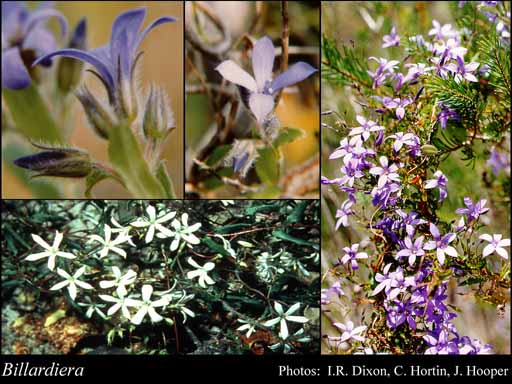- Reference
- Spec.Bot.New Holland 1:1 (1793)
- Name Status
- Current

Scientific Description
Common name. Appleberries. Family Pittosporaceae.
Habit and leaf form. Shrubs (subshrub), or lianas; evergreen. Plants unarmed. Self supporting, or climbing; stem twiners, or scrambling. Mesophytic. Heterophyllous. Leaves small, or medium-sized; fasciculate (sometimes); alternate; leathery; petiolate, or sessile; simple. Leaf blades dorsiventral; entire; linear, or ovate, or oblong, or elliptic. Mature leaf blades adaxially glabrous, or pubescent; abaxially glabrous, or pubescent. Leaf blade margins entire (usually in upper leaves), or serrate (often in lower leaves; sometimes all leaves toothed to lacerated); flat, or revolute.
Reproductive type, pollination. Fertile flowers hermaphrodite. Unisexual flowers absent. Plants hermaphrodite.
Inflorescence and flower features. Flowers solitary, or aggregated in ‘inflorescences’; terminal (usually), or axillary. Inflorescence few-flowered to many-flowered. Flowers in cymes, or in racemes, or in corymbs. Inflorescences terminal (usually), or axillary. Flowers pedicellate; bracteate; small; regular; 5 merous; tetracyclic. Free hypanthium absent. Hypogynous disk present; of separate members (but not prominently lobed). Perianth with distinct calyx and corolla; 10; 2 -whorled; isomerous. Calyx present; 5; 1 -whorled; polysepalous (sometimes imbricate at the base); erect; hairy, or glabrous; exceeded by the corolla. Sepals ovate (to subulate). Corolla present; 5; 1 -whorled; polypetalous (coherent at the base to form a more or less definite corolla tube, petals spreading towards the apex); imbricate; regular; hairy abaxially; glabrous adaxially; plain, or with contrasting markings; white, or cream, or yellow, or purple, or blue. Petals oblong (to spathulate); clawed. Androecium present. Androecial members definite in number. Androecium 5. Androecial members free of the perianth; free of one another. Stamens 5; all more or less similar in shape; isomerous with the perianth; oppositisepalous; all alternating with the corolla members. Filaments sometimes filiform (or subulate). Anthers all alike; dorsifixed; dehiscing via longitudinal slits; tetrasporangiate. Fertile gynoecium present. Gynoecium 2 carpelled, or 3 carpelled. The pistil 2–3 celled. Gynoecium syncarpous; synstylovarious to eu-syncarpous; superior. Ovary plurilocular; 2 locular, or 3 locular; sessile, or stipitate (shortly). Ovary summit usually glabrous. Gynoecium stylate. Styles 1; hairless. Stigmas 1; sometimes capitate. Placentation parietal. Ovules 30–50 per locule (i.e. ‘many’).
Fruit and seed features. Fruit 7–23 mm long; fleshy, or non-fleshy; dehiscent, or indehiscent; a capsule (2-celled), or a berry (1 or 2-celled). Capsules septicidal and loculicidal. Dispersal unit the seed. Fruit 30–50 seeded (i.e. ‘many’). Seeds mucous (often enveloped in a mucilaginous pulp); compressed (but not flat; ovoid, reniform or globose in outline); wingless.
Geography, cytology, number of species. World distribution: Australia. Native of Australia. Endemic to Australia. Australian states and territories: Western Australia, South Australia, Queensland, New South Wales, Victoria, Australian Capital Territory, and Tasmania. South-West Botanical Province. A genus of 25 species; 17 species in Western Australia.
Additional comments. Etymology: named after the French botanist Jacques-Julien Houton de La Billardiere, 1755–1834, who visited Western Australia and Tasmania, and described many new species.
Etymology. After Jacques Julien Houton de La Billardiere (1755–1834), as botanist of Bruni d'Entrecasteaux's voyage 1791–94 visited Western Australia and Tasmania and collected many species; author of Novae Hollandiae Plantarum Specimen (1804–06).